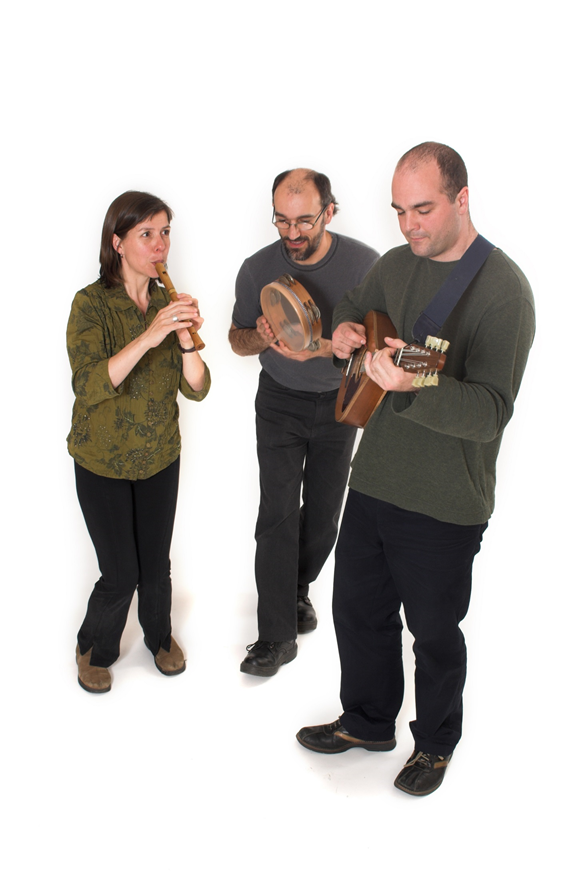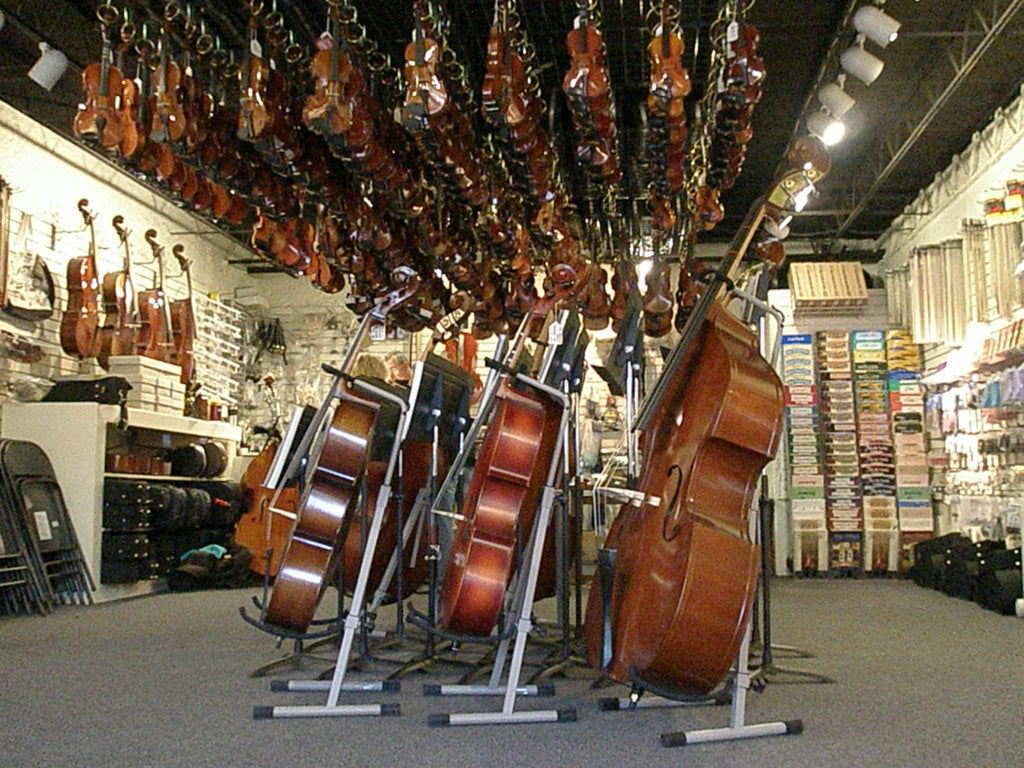From WikiHow
The ability to play a musical instrument is a wonderful thing, and you can never start too early. Children are curious and imaginative by nature, and many will be able to pick up music very quickly, and develop a love for it. The ability to play an instrument and read music will be infinitely helpful later in your child's life, and studies have shown that music can help make a child smarter, develop giftedness, more mature, and more confident. If they're not yet out of elementary school, a good musical background will help them to succeed in middle and high school bands, setting an example for all of their peers.
Step 1: Set an example and motivate your child
If you have any musical talent, play your instrument in front of your child, and answer their curious questions. Let them experiment with it (within reason really young children probably shouldn't be messing with your oboe, especially unsupervised). Talk about your days in school band, how much fun you had back when you took piano lessons, and other things that will pique their interest. Take note if they show a particular interest in a certain instrument.
Step 2: Expose your child to music
Start early - when your child is very young, play quiet music for them and let them fall asleep to CDs of classical music. Once they're older, take them to school and professional concerts, and point out certain instruments. You can also listen to music or watch videos of concerts together. Try to teach them to "feel" the music, and take note of the many things going on at once. Get into the habit of playing classical music in the background when you read, sew, or do something else relaxing. Try to teach them to "feel" the music, and take note of the many things going on at once.
Step 3: Talk to them about music lessons
Forcing your child to learn an instrument, or signing them up for lessons without telling them first, is not going to help foster the love and commitment to music that you want your child to develop. If you had any success with the previous step, they'll probably be eager to start. Ask if there's a particular instrument that they'd like to learn. They may want to try the same instrument you play, or they may say "I don't know", in which case, proceed.
Step 4: Look into your options
If your child is going into middle school, check to see what kind of band and/or orchestra programs are offered. If they're in elementary school, check and see if some of the older grades have a music program. Many elementary schools teach recorder, which is a great starter instrument. Some schools may even offer piano or guitar classes. Otherwise, what lessons are available in your area? To find music instructors, you may want to ask a band director or member of a local band or orchestra.
Step 5: Help your child choose an instrument
You'll want to take several things into consideration... among them, your child's commitment to music (it's possible that they'll lose interest next week... maybe it's not the best idea to go out and buy them a sousaphone), their size (don't give an 8 year old a tenor saxophone, as they won't be able to hold it or support it), and maturity (perhaps the most expensive instrument isn't a good idea, if it'll be in danger from reckless behavior). Once you've got a general idea of what you might be looking for, take them to a music store or arrange for them to meet with a band director to try a number of common "starter" instruments - these are as follows:
Recorder - The recorder is commonly thought to only be for beginners, but is in fact a professional instrument (listen to recordings of Piers Adams, Dan Laurin and Michala Petri). Basic plastic recorders are fairly cheap, and should be purchased for beginners instead of wooden ones, which usually cost hundreds of pounds if they are good quality.
Clarinet -. Bigger and somewhat heavier, but fairly easy to get a sound on and operate. From the clarinet, many students switch to other instruments, such as bass clarinet, oboe, or bassoon.
Flute - Another common instrument in concert bands, the flute can be fairly easy to learn. Keep in mind, however, it can be pretty hard to get the first tone out of a flute, and your child may be discouraged if it takes days or weeks to get it right. Advanced, dedicated flute players may have the opportunity to move up to the piccolo someday, usually after four or five years.
Keep in mind, if you start a very young child on flute, they may need a curved, or J-shaped head joint. A flute with a straight headjoint is about two feet long, and that can hurt small children's shoulders if they play holding it up for a long time. A J-shaped headjoint is shaped like the letter J and takes about 6 inches off the length of the flute. When they're ready, they can graduate to a regular, strait, headjoint. Some student flutes come with both a straight and curved headjoint.
Alto Saxophone - When most people say "saxophone", they're referring to the alto sax. It's the most common saxophone, and is of a size that can be handled by many different ages of people. From the alto sax, students often switch to other sizes of saxophone, such as the soprano (smaller), the tenor (somewhat larger), and the baritone (even bigger than that).
Trumpet/Cornet - The trumpet is a common brass instrument, and the cornet is a smaller instrument that is very similar. Both are popular with beginners and experienced players alike.
Trombone - The trombone is another common brass instrument, that is unique from the others in that it uses a slide instead of valves.
Baritone/Euphonium - These two instruments are often described as "small tubas", and some music programs believe in starting children on baritone or euphonium before switching them to a full-sized tuba. The main difference between the two is that the euphonium has four valves, but the baritone only has three.
French Horn - The French Horn is said to be a more difficult brass instrument to learn, so the choice to start a student on one from the start or to start with another instrument and then switch is usually up to the band director or instructor.
Percussion - Percussion actually refers to many different instruments - drumset, snare drum, timpani, keyboard percussion, auxiliary, and plenty of others, depending on what you can buy or what the school offers.
Violin - The violin is the smallest instrument in the violin family, a popular instrument among younger children who wish to be in an orchestra program.
Viola - The viola is similar to the violin, but a bit larger, has a lower pitch, and plays on a different clef most of the time.
Cello - The cello is a low, bass string instrument, played in an upright position, as opposed to under the neck.
Step 6: Buy, borrow, or rent an instrument
Once you've made a decision. Many music stores offer a rent-to-own program, which may be your best bet if you're not sure your child is dedicated to the instrument yet.
Step 7: Encourage your child to practice
Once they've started taking lessons or practicing with a group, the best way for them to excel at playing is to practice for at least half an hour or so every day. Don't be too harsh about forcing them, but make sure they understand how important it is to practice. Encourage and motivate them, and be sure to congratulate them when they do something exceptionally well.
As your child gets older and more mature, they might want to take up a second instrument, and become a multi-instrumentalist. If you think they can handle it, let them give it a try. Although they can't play both instruments in the same orchestra, they could play their current instrument in the band and just take regular lessons on a different instruments.
Be reasonable when helping the child choose an instrument. If your child could fit into the case, or the instrument is twice as tall as they are, you might want to go a little smaller. You also don't want to pick a rare or less heard-of instrument, such as a contrabass clarinet or mezzo-soprano saxophone. Instruments like these will be hard to find, even harder to find music for, and may be practically impossible to find a teacher for, and most band programs don't have a place for them. Why let them learn the contra-alto flute, only to find that they'll have to switch to a concert flute when they start playing in school.
Stereotypically, flute players are obnoxious, self-centered girly girls. However, there are plenty of successful male flute players, and most females aren't nearly that bad. Trumpet players are said to be big-headed, obnoxious guys, and have a general "I'm better than you" attitude", as well as egos that can be seen from space. Don't listen to this - girls can play the trumpet too, and there are plenty of nice trumpet players with much smaller egos. The list goes on. Although in every section, there may be a few players who conform to such stereotypes, most of the blanket statements just aren't true. Or fair. Avoid stereotypes and the old standards. There's no rule that says your child should learn the violin, or that you have to force them to take piano lessons until they're teenagers. Many children learn to play other instruments such as the tuba or oboe as young children. Perhaps that kills some of the common stereotypes of child musicians, but if they do well with it, stereotypes should be the last thing on your mind.
Continue reading








 NPR's Cory Turner writes:
NPR's Cory Turner writes:
 Finding the right instrument for your child is a difficult but important factor in your child’s continued musical success. Forcing a child to play an instrument rarely leads to the love of music making we want. Here are some components to consider when helping your child choose the right instrument.
Finding the right instrument for your child is a difficult but important factor in your child’s continued musical success. Forcing a child to play an instrument rarely leads to the love of music making we want. Here are some components to consider when helping your child choose the right instrument.